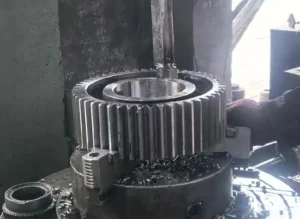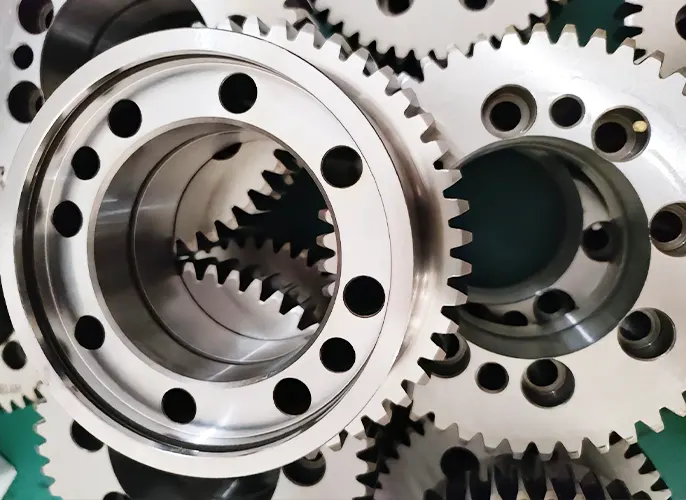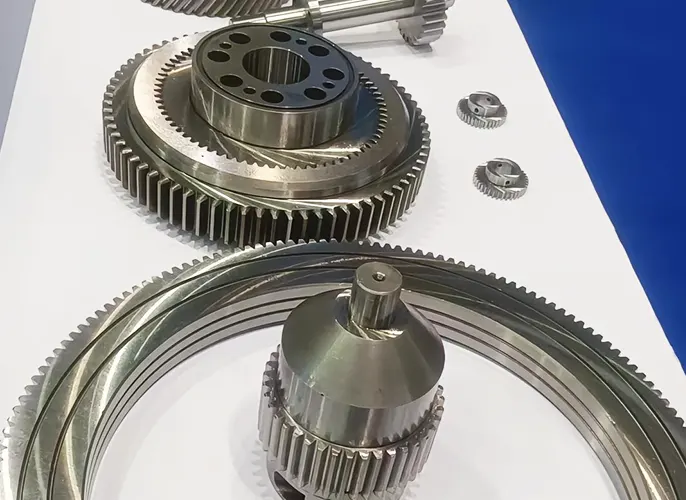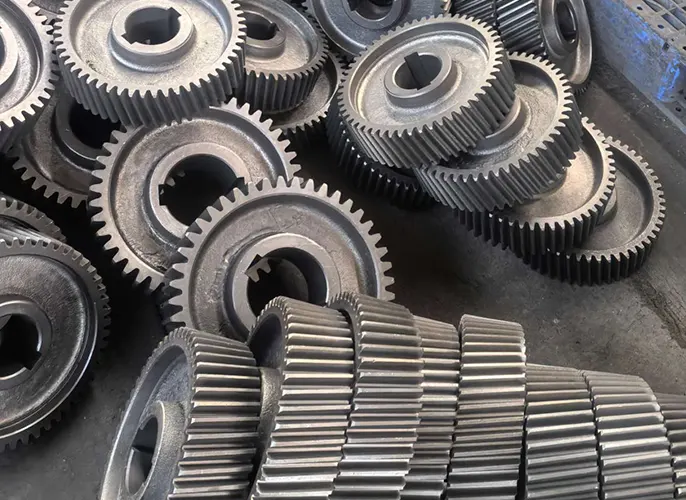With the rapid development of modern industry, the demand for high-precision gear machining process is more and more urgent.
Gears, as the most common type of transmission device in the mechanical transmission system, are widely used in various fields, such as the automotive industry, aerospace, engineering machinery and so on.
Gear performance directly affects the efficiency and reliability of the transmission system, so the manufacturing requirements for gears are becoming increasingly stringent.
The traditional gear machining process has certain limitations, making it challenging to meet the requirements of high-precision gear manufacturing.
This paper provides an in-depth study of the machining process of high-precision gears.
It focuses on the key technologies and research results of high-precision gear machining to provide guidance and reference for developing high-precision gear machining technology.
Importance of high precision gears and application areas
(1) The importance of high precision gears.
A high-precision gear is a mechanical part that can provide accurate transmission and stable operation. Its accuracy and reliability are crucial to the performance and life of the mechanical system.
Through precise tooth shapes and dimensions, high-precision gears can achieve more minor transmission errors and higher efficiency.
This enables mechanical systems to reduce energy losses, improve efficiency, and lower energy consumption during operation.
The manufacturing process and material selection of high-precision gears are very strict, reducing friction loss and noise generation in the working process.
This can not only extend the service life of the mechanical system but also improve the stability and reliability of mechanical equipment’s operation.
(2) The application fields of high-precision gears.
High-precision gears have essential applications in some special fields.
For example, the requirements for precision transmission and high-speed operation are very high in aerospace, precision machinery manufacturing, automotive, high-speed trains, and other fields.
High-precision gears can meet these requirements and ensure the mechanical system’s accuracy and stability, as well as its safety and reliability.

Status quo and challenges of gear processing
(1) The limitations of the traditional gear processing technology.
The traditional gear processing process has limitations to a certain extent, which are mainly reflected in the following aspects:
First, the productivity of the traditional gear processing process is relatively low.
Traditional gear processing usually adopts cutting methods, and it is complex. It involves several different processes and requires multiple clamping and adjustments.
The process is cumbersome, which greatly reduces productivity. In addition, the processing cycle is long due to the need for multiple cutting operations.
This results in a long production cycle and cannot meet the demand for high-volume, high-efficiency production.
Secondly, the processing accuracy of the traditional gear machining process is limited.
It is challenging to meet the high-precision machining requirements of the traditional cutting process. This is especially true for processing large gears and high-precision gears, which is even more difficult.
The cutting process generates a certain amount of cutting force and cutting temperature. This can easily cause machining and thermal deformation, impacting processing accuracy and quality.
Third, the traditional gear processing process has relatively low material utilization.
This is because the conventional cutting process requires removing much material from the workpiece.
As a result, a significant amount of material waste occurs.
This leads to low material utilization, which does not align with the requirements of sustainable development.
Fourth, the traditional gear machining process requires higher operator skill levels.
This is because conventional machining methods require multiple clamping and adjustments.
The process flow is complex, demanding skilled operators. Additionally, workers need to be able to handle and work on the gears throughout the process.
The process is complex, requiring workers to have a high level of technical and operational experience.
The operation process is susceptible to the influence of the worker’s own factors, increasing the operational risk.
(2) The challenges of high-precision gear processing.
With the development of science and technology and industrial progress, high-precision gear processing has become increasingly important.
High-precision gears are widely used in modern machinery manufacturing in various fields, such as the automotive industry, aircraft manufacturing, the shipbuilding industry, and so on.
However, high-precision gear processing faces a series of challenges.
First, high-precision gear processing requires extremely high precision and stability.
Gears’ processing accuracy directly affects their effectiveness and lifespan.
Therefore, the processing requirements for high-precision gears are very high. Their manufacture requires the use of precision machining equipment and advanced machining technology.
At the same time, maintaining the stability of the processing process is crucial.
This presents a challenge for machining enterprises, as they must invest significant money to purchase high-precision machinery and equipment.
Additionally, they must train workers to master advanced processing technology.
Secondly, high-precision gear processing needs to overcome material and process challenges.
Some high-strength and high-hardness metal materials, such as steel and aluminum alloy, are often used to manufacture high-precision gears.
These materials are more difficult to process, which can easily lead to cutting tool wear, reduced machining accuracy, and other problems.
At the same time, high-precision gear processing also needs to consider the selection of process parameters such as machining speed, depth of cut, and tool life. This places higher requirements on the optimization of processing technology and the development of new technologies.
Third, high-precision gear processing requires high technical personnel and management capabilities.
It requires workers with precision machining technology and skilled machining equipment operation and maintenance.
At the same time, it also requires process engineers to be able to design a reasonable process and optimize the processing parameters. In addition, high-precision gear machining requires strong management capabilities.
These capabilities include reasonably planning production schedules, deploying human resources, and ensuring quality control.

Key technologies for high-precision gear processing
(1) Improvement and innovation of gear processing equipment.
With the development of advanced manufacturing technology and the increase in market demand for high-quality, high-precision gear, traditional gear processing equipment has been unable to meet the requirements.
First, enhancing its accuracy and stability is the key to improving gear processing equipment.
To manufacture high-precision gears, structural design and process improvements on the original equipment are necessary.
For example, introducing more precise spindles and tables, using high-stiffness machine tool structures, and adding adaptive control systems can significantly improve the processing accuracy of gear machining equipment.
Secondly, introducing advanced processing technology and techniques is the key to innovative gear processing equipment.
For example, advanced CAD/CAM software design and simulation technology can comprehensively design and analyze gears before processing.
This helps detect potential processing problems in advance and reduces the chances of machining errors.
At the same time, introducing high-speed cutting technology and hard material cutting tools can improve gear processing equipment’s processing efficiency and quality.
In addition, improving the automation and intelligence level of gear processing equipment is also crucial for its advancement.
Human intervention can be reduced to improve machining efficiency and consistency through the introduction of automatic tool loading and unloading systems, automatic slag removal devices, and other equipment.
At the same time, strengthening the monitoring and control of the machining process can help improve the equipment’s operational stability.
By realizing intelligent management and optimal control of the equipment, the production efficiency of the gear processing equipment can also be improved.
(2) Measurement and inspection technology of high-precision gears.
In the gear processing process, accurate measurement and inspection of gear precision can ensure that the gear products meet the design requirements of high precision standards.
Measurement and inspection technology requires accurate measuring tools and equipment.
The equipment usually used includes gear measuring machines, gear testers, optical measuring instruments, etc.
These devices can accurately measure and evaluate gears’ various dimensions, shapes, positions, etc..
Measurement and inspection technology mainly includes the following aspects:
First, gear tooth pitch measurement:
Tooth pitch is one of the most basic dimensional parameters in gear processing and an important indicator of gear transmission performance.
Commonly used tooth pitch measurement methods include direct, cycloid, and optical methods.
These methods can accurately measure gears’ tooth pitch. This ensures the gears’ transmission performance and reduces interference between them.
Second, measurement of gear tooth shape:
Tooth shape is the shape of the gear tooth surface characteristics of the gear transmission.
The gear transmission’s performance impacts the commonly used tooth shape measurement methods, including the cycloid, optical, and contouring methods.
Commonly used tooth shape measurement methods include the pendulum, the optical, and the contour methods.
Through these methods can measure the shape, error, and fluctuation of gear tooth shape, to ensure the gear transmission accuracy and smoothness;
Third, gear axial measurement:
The gear’s axial position is crucial to the transmission’s stability and accuracy. Commonly used gear axial measurement methods include altimeters and micrometers.
These methods can measure the axial distance and axial deviation of the gears. This helps ensure their stability during the transmission process and reduces interference between them.
Fourth, the gear gauge calibration:
Gear gauges are commonly used measurement tools in the gear processing process. They need to undergo regular calibration to ensure the accuracy of the measurement results.
Calibration methods include precision gauge calibration and reference gear calibration. Calibration work helps improve the accuracy of the gear gauge’s measurement.
This ensures that the gear processing meets high-precision requirements.
(3) High-precision control technology in bevel gear processing.
A series of high-precision control technologies must be used to ensure the high precision of bevel gear machining.
First, high-precision control in bevel gear machining requires ensuring the tool’s and workpiece’s geometric accuracy during the machining process.
This can be achieved by strictly controlling the tool’s manufacturing and grinding processes. The tool’s geometric parameters, such as tooth profile and tooth width, need to be precisely calculated and controlled.
In addition, precision tool fixtures and machining fixtures can be used to ensure the tools’ stability and positioning accuracy.
These measures help avoid tool and workpiece deviation and vibration during the cutting process. As a result, machining accuracy can be effectively guaranteed.
Secondly, the high-precision control in bevel gear machining needs to consider the precision and stability of the machine tool during the machining process.
The precision of the machine tool directly affects the gear’s machining accuracy. Therefore, it is necessary to pay close attention to the machine tool’s precision and stability during its selection and commissioning.
At the same time, measures such as increasing the rigidity of the machine tool and enhancing its dynamic accuracy through structural reinforcement can be adopted.
These measures help reduce transmission errors and improve machining quality.
In addition, regular maintenance and repair of the machine tool are also key to maintaining its accuracy.
Finally, the high precision control in bevel gear machining must also consider the measurement and feedback control technology.
The use of high-precision measuring equipment allows for the accurate measurement of the gear size in the machining process and timely feedback to the machine tool for correction.
This can ensure that the accuracy of the gear size in the machining process meets the requirements.
In addition, adaptive control algorithms can be used to optimize and adjust the processing parameters to improve the processing accuracy further.
(4) Optimization of tool selection and cutting parameters in high-precision gear machining.
The selection of cutting tools has an important impact on the accuracy and surface quality of high-precision gear machining.
Suitable tools can provide better cutting performance and machining stability, thus ensuring high-precision gear machining.
Factors to Consider When Selecting Cutting Tools
When selecting tools, the material of the gear and the required machining accuracy should be considered.
Tools with good wear resistance and high hardness, such as carbide tools, should be selected for gear materials with high hardness.
Precision tools, such as PCD tools, should be selected for gears requiring high machining accuracy.
In addition, factors such as the number of tool edges, tool size, and sharpening condition should also be considered to meet the specific processing needs.
Optimization of Cutting Parameters
Setting cutting speed, feed rate, and depth of cut reasonably can improve machining efficiency and quality.
When selecting the cutting speed, the tool material’s wear resistance and the machined surface’s quality requirements should be considered.
Generally speaking, a higher cutting speed can improve machining efficiency, but it can also easily cause excessive tool wear and roughness of the machined surface.
Therefore, the appropriate cutting speed should be selected to meet the machining accuracy requirements.
In addition, the feed rate selection and cut depth should be based on the tool material and machining conditions.
These factors should be comprehensively considered to ensure the stability of the machining process and the consistency of machining quality.
Application and Management of Cutting Fluid
Cutting fluid can reduce the cutting temperature, reduce friction and wear, and improve the quality of the machined surface.
In high-precision gear machining, suitable cutting fluid should be selected and used reasonably.
The selection of cutting fluid should consider the requirements of material and machining accuracy and be tested and verified accordingly.
At the same time, attention should be paid to keeping the cutting fluid clean and circulating to ensure its performance and stability.

Application cases of the high-precision gear machining process
(1) Mechanical manufacturing field.
In machinery manufacturing, the high-precision gear machining process is widely used in the transmission systems of precision machine tools and industrial robots.
High-speed machining centers are usually required for high-speed, high-precision, and high-efficiency machining.
The stability and accuracy of the gear transmission system play a crucial role in ensuring the machining quality.
The traditional gear machining process often cannot meet the requirements of high-speed machining centers.
During high-speed rotation, the gear drive system generates a lot of vibration and noise, which negatively affects processing quality and efficiency.
Using high-precision gears can effectively reduce vibration and noise, and improve the smoothness and precision of the transmission.
High precision gear machining process can be realized through the following aspects.
Firstly, the selection of materials is critical. High-strength and high-hardness materials need to be selected to ensure the wear resistance and stability of the gears.
Secondly, manufacturers should use advanced processing equipment and technologies—such as precision grinding, tooth grinding, and mesh detection—to ensure the accuracy and flatness of the gears;
Finally, technicians should carry out precise assembly and debugging to ensure the gear transmission system operates normally.
(2) Aerospace.
The aeroengine is the power source of the airplane, and the transmission system plays a vital role in this.
High-precision gears in this system transmit power and rotate shafts.
Due to the engine’s high-speed rotation and the extreme working conditions, high-precision gears must have a strong load-bearing capacity and anti-wear ability.
At the same time, the gear’s transmission accuracy is also crucial, determining the transmission’s efficiency and stability.
Therefore, the high-precision gears used in aircraft engines need to undergo precise machining processes to ensure their quality and performance.
In addition to the engine transmission system, the flight control system also requires high-precision gears to achieve accurate control and adjustment.
The flight control system is critical to the aircraft’s operation, enabling the pilot to issue control commands during the flight process.
It involves key actions such as the aircraft’s attitude adjustment, take-off, and landing operations. In the flight control system, high-precision gears transfer the pilot’s input force and torque.
This ensures that the aircraft can perform actions according to the intended instructions. Thus, high-precision gears are essential to guarantee that the aircraft responds accurately to the pilot’s scheduled commands.
This requires high-precision gears to be highly reliable and stable in the working process.
The aerospace industry’s application of high-precision gears is very demanding, and the process requirements are even higher.
In the processing process, fine cutting technology is necessary to ensure the precision and quality of gears.
At the same time, advanced testing equipment and technology are also necessary to carry out strict quality inspections on high-precision gears.
Only under such technological conditions can we produce high-precision gears to meet the requirements of the aerospace field.
(3) Automobile manufacturing field.
The automobile industry also significantly demands gear transmission systems, especially for high-performance and electric cars.
Applying high-precision gears can improve the power transmission efficiency and driving experience of automobiles.
Meanwhile, high-precision gears can improve the reliability and durability of key components such as automatic transmissions and differentials.
Conclusion
With the continuous advancement of modern industry, the demand for high-precision gear manufacturing has become increasingly critical.
Gears, as fundamental components of mechanical transmission systems, play a pivotal role in the automotive, aerospace, and precision machinery industries.
Their performance directly determines mechanical systems’ efficiency, stability, and reliability.
Traditional gear processing technologies face significant limitations in meeting the stringent requirements of high-precision manufacturing.
Challenges such as low production efficiency, limited processing accuracy, material wastage, and high skill requirements highlight the need for technological innovation.
Significant progress has been made in gear manufacturing through the improvement and innovation of gear processing equipment, the adoption of advanced measurement and inspection techniques, and the implementation of high-precision control technologies.
These advancements ensure higher accuracy and stability in gear production, enhance overall efficiency, reduce operational costs, and meet the growing demand for high-performance mechanical systems.
The development of intelligent, automated, and digitalized gear manufacturing technologies will become the key trend in the future.
Continuous research and innovation in high-precision gear processing will strongly support the evolution of modern industries and contribute to the realization of more efficient, reliable, and sustainable manufacturing systems.
FAQ
Why is high-precision gear machining important in modern industry?
High-precision gears ensure accurate power transmission, reduce energy loss, lower noise, and enhance system reliability. They are critical for improving performance and lifespan in high-end applications such as aerospace, automotive, and precision machinery..
What industries rely most heavily on high-precision gears?
High-precision gears are essential in:
Aerospace (e.g., jet engine and flight control systems)
Automotive (e.g., transmissions and electric drivetrains)
Precision machinery (e.g., CNC machine tools, robotics)
Railway and shipbuilding industries
These sectors require high-speed, high-load, and high-accuracy gear performance.
What are the main limitations of traditional gear machining methods?
Traditional gear machining suffers from:
Low production efficiency due to multi-step processes
Difficulty achieving ultra-high accuracy
High material waste during cutting
High dependence on skilled operators and manual adjustments
These issues make traditional methods unsuitable for modern high-precision demands.
What are the core challenges in high-precision gear processing?
Key challenges include:
Maintaining tight dimensional and geometrical tolerances
Machining hard-to-cut materials like hardened steels and alloys
Minimizing thermal and mechanical deformation
High costs of equipment, tooling, and skilled labor
Meeting these demands requires precision tools, process optimization, and advanced machinery.
What equipment innovations are improving high-precision gear machining?
Innovations include:
High-rigidity, high-accuracy CNC gear grinding and cutting machines
Use of adaptive control systems for real-time compensation
Integration of CAD/CAM simulation and digital twin technologies
Automation systems like robotic tool changers and automated part handling
These technologies boost precision, reduce cycle time, and improve consistency.
What role does measurement and inspection play in gear machining?
Accurate inspection ensures gears meet design specs. Key technologies include:
Gear measuring machines for pitch and profile accuracy
Optical and 3D scanning tools for tooth shape and form
Axial runout and concentricity checks
Calibration of gear gauges for consistent quality assurance
Real-time feedback enables quick adjustments to maintain high tolerances.
How is high-precision control achieved in bevel gear machining?
High-precision bevel gear machining uses:
Ultra-precise cutting tools and fixtures
Stable and rigid machine tools with minimal vibration
Real-time feedback and compensation systems
Adaptive control algorithms to adjust machining parameters dynamically
These approaches help minimize errors caused by tool deflection, heat, or mechanical stress.
How are cutting tools and parameters optimized for gear accuracy?
Tool selection and parameter tuning are critical. Considerations include:
Using carbide or PCD tools for hardness and wear resistance
Optimizing cutting speed, feed rate, and depth of cut based on material
Proper use of cutting fluids to reduce temperature and friction
Tool maintenance and condition monitoring to ensure consistent cutting
All contribute to maintaining surface finish and dimensional accuracy.
What are common applications of high-precision gear machining?
Typical applications include:
Machine tools: Ensuring smooth, vibration-free movement
Aeroengines: Withstanding high speeds and temperatures
Flight control systems: Guaranteeing safety and responsiveness
Electric vehicles and transmissions: Enhancing energy efficiency and torque delivery
These cases highlight the necessity of high-performance and reliability in gear systems.
What trends will shape the future of high-precision gear manufacturing?
Future trends include:
Smart and autonomous machining systems
Digitalization and Industry 4.0 integration
Eco-friendly manufacturing using optimized material usage and energy-saving processes
Advanced materials and coatings for extended tool and gear life
AI and machine learning for process optimization and fault prediction

